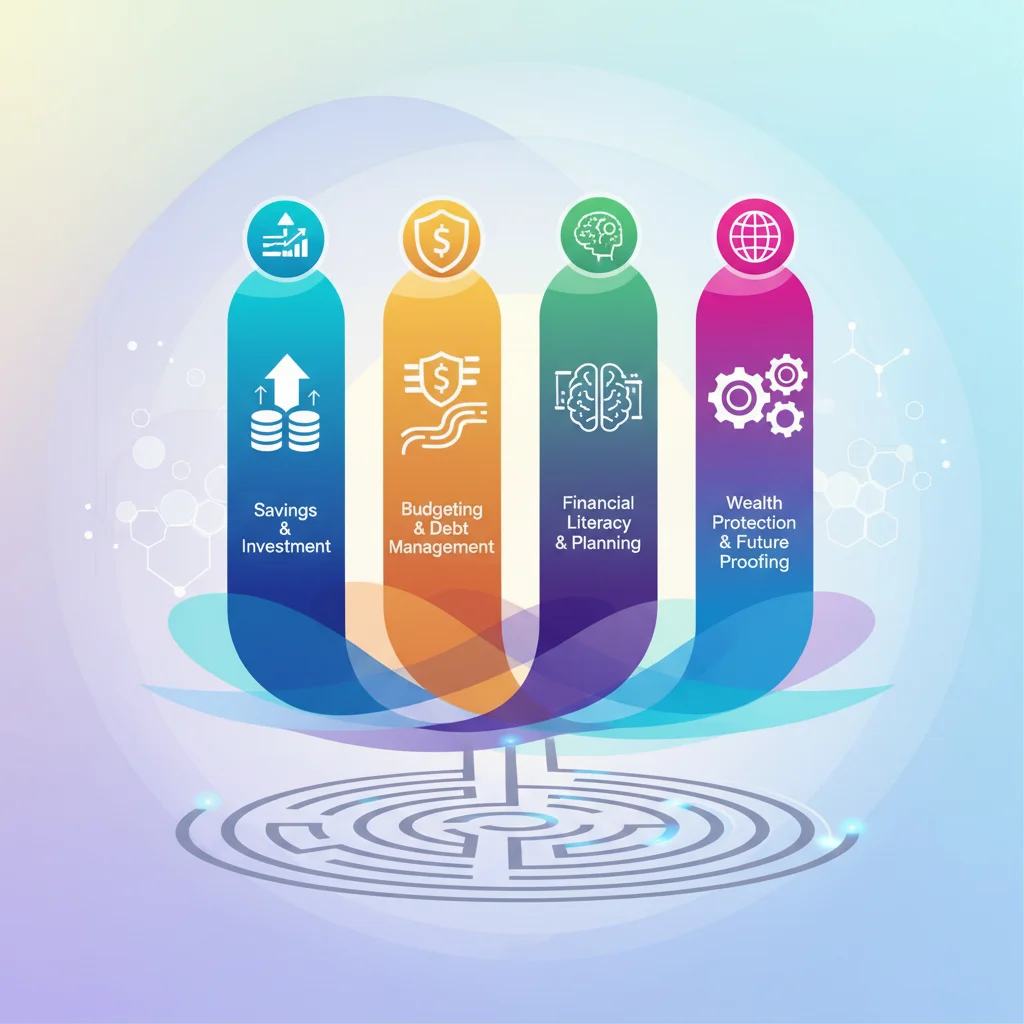
Mastering Your Financial Future: Four Pillars of Modern Money Management
In today’s complex global economy, achieving financial stability can feel like navigating a labyrinth. The constant hum of stock market fluctuations, shifting economic policies, and the rapid evolution of financial technology can be overwhelming. Yet, beneath this complexity lies a simple truth: mastering your money isn’t about predicting the future or discovering a secret formula. It’s about building a robust, personal financial system grounded in timeless principles, now supercharged by modern tools. While many struggle to get started, the path to financial empowerment can be broken down into four foundational pillars.
Inspired by the simple premise of finding easy ways to manage money better, as highlighted by a recent BBC article, this guide expands on that idea. We will move beyond mere tips and construct a comprehensive framework for not just managing, but truly commanding your financial destiny. These four pillars—Conscious Budgeting, Strategic Debt Management, Intelligent Investing, and Leveraging Financial Technology—are designed to work in concert, creating a powerful engine for wealth creation and security for everyone from the curious novice to the seasoned finance professional.
Pillar 1: Architecting Your Financial Blueprint with Conscious Budgeting
The word “budget” often conjures images of restrictive spreadsheets and penny-pinching. It’s time to reframe this concept. A budget is not a financial diet; it is the architectural blueprint for your financial life. It’s a tool for conscious decision-making that aligns your spending with your values and long-term goals. Without this blueprint, financial decisions become reactive rather than proactive, leaving you vulnerable to market volatility and personal economic shocks.
Effective budgeting is about understanding your personal cash flow—the intricate dance of money entering and leaving your accounts. The goal is to direct this flow with intention. Several methodologies can serve as a starting point:
- The 50/30/20 Rule: A popular framework that allocates 50% of after-tax income to needs (housing, utilities, groceries), 30% to wants (dining out, entertainment), and 20% to savings and debt repayment. It’s simple and provides a balanced approach.
- Zero-Based Budgeting: A more granular method where every single dollar of income is assigned a job—whether it’s for spending, saving, investing, or debt repayment. This ensures no money is wasted and maximizes efficiency.
- Pay-Yourself-First Method: This prioritizes savings and investing. Before any other bills are paid, a predetermined amount is automatically transferred to savings or investment accounts. The rest is then available for expenses. This automates good habits and builds wealth systematically.
The power of this pillar lies in the data it provides. By understanding where your money goes, you can identify inefficiencies and opportunities. This isn’t about cutting out lattes; it’s about asking if that $5 daily coffee brings you more value than contributing an extra $1,825 a year towards an investment that could grow exponentially. With U.S. household debt reaching over $17 trillion in 2023, having a clear financial blueprint is no longer a recommendation—it’s an economic necessity for personal stability.
Pillar 2: Strategic Deleveraging and Managing Debt
Debt is one of the most misunderstood concepts in modern finance. It’s often portrayed as an unmitigated evil, but in reality, its impact is far more nuanced. The key is to differentiate between productive (“good”) debt and destructive (“bad”) debt. Productive debt is an investment that can increase your net worth or future income, such as a mortgage on an appreciating property or a student loan for a high-demand profession. Destructive debt, typically high-interest consumer debt from credit cards or personal loans, finances depreciating assets or consumption and actively erodes your wealth.
Strategic deleveraging involves a two-pronged approach: aggressively eliminating destructive debt while intelligently managing productive debt. Two popular methods for tackling high-interest debt are:
- The Avalanche Method: This involves making minimum payments on all debts while directing any extra funds to the debt with the highest interest rate. Mathematically, this is the most efficient method, saving you the most money on interest over time.
– The Snowball Method: This strategy focuses on psychological wins. You make minimum payments on all debts but focus on paying off the smallest balance first, regardless of the interest rate. The momentum from clearing each small debt can provide the motivation to continue.
Understanding the connection between your personal debt and the broader economy is crucial. When central banks adjust interest rates to manage inflation, it directly impacts the cost of your variable-rate loans. This macroeconomic link underscores the importance of minimizing high-interest liabilities to insulate your personal finances from the volatility of the global economy. Sunshine and Spending: Is the UK's Record Retail Surge a Turning Point for the Economy?
Pillar 3: The Growth Engine – Intelligent Investing in the Digital Age
Saving money is about wealth preservation; investing is about wealth creation. It is the single most powerful tool for outpacing inflation and building substantial, long-term net worth. The magic behind investing is the principle of compound interest, where your returns begin to generate their own returns, creating an exponential growth curve over time. An early start, even with small amounts, can have a profound impact due to this compounding effect.
The modern stock market, once the exclusive domain of Wall Street professionals, has been democratized through technology. However, access does not equal success. Intelligent investing is built on core principles:
- Risk Tolerance: Understanding your personal capacity and willingness to withstand market downturns. This dictates your asset allocation—the mix of different investments in your portfolio.
- Diversification: The age-old wisdom of not putting all your eggs in one basket. Spreading investments across various asset classes, industries, and geographic regions helps mitigate risk.
- Long-Term Horizon: Successful investing is rarely about short-term trading. It’s about buying into quality assets and holding them for years or decades, allowing them to grow through economic cycles.
To help visualize how different assets function within a portfolio, consider the following comparison:
| Asset Class | Typical Risk Profile | Potential Return | Liquidity | Primary Role in Portfolio |
|---|---|---|---|---|
| Stocks (Equities) | High | High | High | Long-term growth engine |
| Bonds (Fixed Income) | Low to Medium | Low to Medium | High | Stability, income generation, and capital preservation |
| Real Estate | Medium | Medium to High | Low | Income (rent), inflation hedge, and appreciation |
| Alternatives (e.g., Blockchain Assets) | Very High | Very High | Varies | High-risk growth, diversification, potential future tech play |
The rise of retail trading platforms has made participating in the stock market easier than ever. However, this accessibility also comes with the temptation of speculative trading. For most investors, a disciplined approach using low-cost index funds or ETFs (Exchange-Traded Funds) is a more reliable path to success than attempting to time the market. The Global Wealth Matrix: Navigating Risk, Law, and Culture in the New Economy
Pillar 4: The Technological Edge – Leveraging Fintech for Financial Supremacy
The final pillar is what separates traditional money management from its modern counterpart: the strategic use of financial technology (fintech). The fintech revolution has dismantled old barriers in the banking and finance industries, offering consumers unprecedented access, efficiency, and options.
Harnessing fintech is about using technology to optimize the other three pillars. Here’s how:
- For Budgeting: AI-driven apps like Mint, YNAB, or Copilot automatically track your spending across all accounts, categorize transactions, and provide insights into your financial habits. They are the automated architects of your financial blueprint.
- For Debt & Savings: Online banks often offer high-yield savings accounts with interest rates far exceeding those of traditional brick-and-mortar institutions, allowing your emergency fund to grow faster. Other apps help automate extra debt payments or round up purchases to accelerate savings.
- For Investing: Robo-advisors such as Betterment and Wealthfront have democratized sophisticated investment management. They use algorithms to build and maintain a diversified portfolio based on your risk tolerance, all for a fraction of the cost of a traditional financial advisor. This is a prime example of financial technology making expert-level strategies accessible to the masses.
Looking ahead, the intersection of fintech and blockchain technology promises even more profound changes. Decentralized Finance (DeFi) aims to build a new financial system that is more open, transparent, and accessible, without traditional intermediaries like banks. While still an emerging and volatile space, understanding the potential of blockchain is becoming increasingly important for any forward-thinking investor. The global adoption of fintech is staggering, with a projected 65.3% of the world’s banked population expected to be using digital banking services by 2026, signaling a permanent shift in how we interact with our money. Beyond the Shopping Cart: What Gold, Tech, and a Sunny Summer Tell Us About the Real Economy
Conclusion: Your Journey to Financial Command
Building a secure financial future is not a passive activity; it is a dynamic process of continuous learning and adaptation. The four pillars—Conscious Budgeting, Strategic Debt Management, Intelligent Investing, and Leveraging Fintech—provide a comprehensive framework for success in the modern economy. They are interconnected and mutually reinforcing. A solid budget frees up capital for investing. Smart debt management improves your credit and reduces financial drag. Intelligent investing grows your capital base, and fintech acts as a powerful accelerant for all three.
The journey begins not with a grand, sweeping overhaul, but with a single, deliberate step. Choose one area to focus on today. Set up a budgeting app, analyze one source of debt, open a high-yield savings account, or research a low-cost index fund. By taking small, consistent actions, you build the foundation for lasting financial independence and transform yourself from a mere participant in the economy into the confident architect of your own financial future.


